Content from the Brookings-Tsinghua Public Policy Center is now archived. Since October 1, 2020, Brookings has maintained a limited partnership with Tsinghua University School of Public Policy and Management that is intended to facilitate jointly organized dialogues, meetings, and/or events.
What’s in store for U.S. energy policy under a President Trump? He’s promised to pump more oil and gas, restore the coal industry, and roll back regulations, writes David Victor, but hasn’t put forth a clear plan for doing so. This post is adapted from a piece that originally appeared on Yale 360.
With the unexpected triumph of Donald Trump, what’s in store for U.S. energy policy? He promises to pump more oil and gas, restore the coal industry, and roll back regulations, but those claims are not rooted in any plan for how to achieve them. In my lifetime, no one has ever become president after having said so little about what they would actually do with the reins of power.
With so little to guide predictions, the reality of a Trump presidency has become a national Rorschach test. Conservatives and the anti-establishment imagine an ascendant Trump will set a path for a more competitive national economy, smaller government, and a stronger defense. The left predicts a horror show of policy reversals and seediness. This Rorschach test is now playing out as the country grapples with what all this means for climate and energy.
Domestic policy is particularly hard to parse. Don’t expect any climate change initiatives by a Trump administration, which means that efforts started under Obama to understand and prepare for the impacts of climate change will be put on hold—to the country’s detriment. But on emissions, national policy is almost synonymous with energy policy, since most warming emissions come from the energy sector. Trump won’t adopt any new policies to control emissions, but a huge effort already is under way. Despite claims of trashing regulations, rolling back the Clean Power Plan, and a big shift toward fossil fuels, four years of Trump will actually have very little impact on national energy investment patterns and policy that are already largely grounded. That’s because the energy sector is slow to change, most policies are enshrined in law and difficult to unseat, and the very thought of a Trump administration overseeing national energy policy will inevitably shift more of the action to the states.
Domestic energy production under Trump
What the United States does at home will also eventually have an effect on the world, as few nations will go far in making costly reductions if other economic powerhouses are not doing the same. This is where friends of American engagement must work rigorously and immediately to help the rest of the world understand that a Trump administration will actually achieve almost none of its stated policy goals, even when domestically, U.S. energy policy won’t much change, at least over four years.
Getting expectations right is crucial, and it is instructive to harken back to the first years of the Reagan administration—a new government that also offered a national Rorschach test. The administration was consumed with the chaos of governing (mostly poorly when it appointed agency heads at EPA, Interior and other vital places that were openly hostile to the business of government). With adult supervision and a pivot into the center, Reagan earned a second term and the outcomes for the country were much more internationalist and much less destructively radical in terms of energy and environmental policy than feared. A lot has changed since then, of course—notably, the evisceration of the center of American political leadership, especially centrist Republicans—but while a lot of glass may break when a bull is put into the fragile China-shop of U.S. government, surprisingly little actually happens quickly in response.
Clean energy policies and regulations
The Trump campaign and its policy websites suggest there will be a big rollback of regulation—in particular, rules that have a disproportionate impact on small business. But most of what really matters in current federal administrative law on energy and the environment requires notification and review and is not easily reversed.
The acid test for regulatory rollback will be the recently completed Clean Power Plan. The president, no matter how hostile his administration might be to such actions, can’t easily nullify them, though the courts might do that job for him. Fully unraveling the plan’s effects will take many years and may be impossible to completely achieve because many compliance efforts are already underway in industry. There are also other state and federal policies that reinforce the plan. So, while we may see the burgeoning coalition for carbon taxation regrettably go back into hibernation, the scenarios that see Trump soon making America smoggy again may not play out in the real world.
Oil and gas production
Overall, the effect of Trump’s victory on oil and gas production is likely to be small. Most such production relies on private lands (or public leases), and the regulatory apparatus for oil and gas won’t change much. Public lands could be different, and one of the most important appointments to watch is the head of the Department of Interior. But in 2014, 21 percent of U.S. oil production and 14 percent of gas came from federal lands, according to the most recent data from the Energy Information Administration. A Trump presidency presumably will ease the process for leasing on federal lands, although any such changes will surely be tied up in the courts as will efforts to speed approval of pipeline projects—where many states will defy the federal government as pipelines become a key symbol in the “keep in the ground” movement. Regulation by EPA of shale gas operations to reduce emissions of methane (a powerful greenhouse gas) and improve management of water that is used and produced in these wells will presumably be slowed or stopped. But it was already becoming clear that such rules would not have a ruinous effect on drilling—they would be, instead, a compliance cost that with effort would become easier to manage.
Perhaps one of the greatest difficulties for the oil and gas industry will be to avoid treating a Trump presidency as a blank check for any production and infrastructure here in the United States.
Because a Trump foreign policy looks likely to be a reckless one, it is possible that troubles stirred up around the world will affect the global oil markets (and to a lesser degree gas, which is harder to transport globally and thus less of a globally-traded fuel). It could be that those reverberations have a much bigger impact on U.S. oil and gas operations than anything that a Trump administration does with regulation. When oil prices rise, so does drilling in areas that can respond quickly to the economic opportunity—such as the U.S. onshore shale plays.
Perhaps one of the greatest difficulties for the oil and gas industry will be to avoid treating a Trump presidency as a blank check for any production and infrastructure here in the United States. Oil and gas companies looking to the long term will need to keep working to find smart ways to reduce emissions and environmental footprints and to sustain public trust—even if the federal government doesn’t help them with that mission by offering the credible threat of regulation. Restraint on the left will be equally difficult since the symbol of Trump in the White House will offer a feeding frenzy of fundraising opportunities for those who are fearful of Trump regulatory rollbacks. Highly symbolic actions—more pipeline protest, surely, which could become for the current youth what the Earth Day events and southern sit-ins were for earlier generations—will follow. But these will have little impact on actual global emissions; much more important (but less visible and sexy) will be legal and administrative defenses of existing law if not expansion.
Coal
I suspect there is no fuel for which the Trump victory will be more irrelevant than for coal. While much coal is produced on federal lands (about 41 percent), the problem with coal is not access to supply but demand for the product. Natural gas is so inexpensive that it is clobbering coal even without more environmental regulation. The Clean Power Plan will cement that role for gas into place—with important questions about whether gas is a true transition fuel or a dead end in efforts to make deep cuts in greenhouse gases. I worry that those important questions will be ignored for the next 4 years—possibly making it harder for the nation to adopt a rational approach to addressing climate change.
I suspect there is no fuel for which the Trump victory will be more irrelevant than for coal.
But the reality now and for the foreseeable future is that coal is shrinking. Trump, of course, won the coal belt decisively—indeed, he won nearly all of rural America while the cities went more strongly for Clinton—but the claims he made about rebuilding coal will soon be revealed as pure nonsense. Managing the decline of coal and making sure that the coal plants that remain are clean and efficient will be the real task for that industry in the coming years, but that’s something that will happen with or without the federal government paying attention.
Electric power
The big, important unknown about Trump’s energy plans is in electric power. The candidate himself was essentially silent on the question during the campaign, except for swipes at renewable power and statements that any candidate could have made about letting competition choose the best energy sources. But as a I wrote in a pre-election brief for Brookings, since the 1970s the frontier for important energy policy decisions has shifted from a focus on fuels (e.g., the oil markets, which now largely function globally) and toward infrastructure, especially electricity.
The problem is that any influence on electric power supply and infrastructure that the federal government may have comes in subtle ways that require carefully crafted policy strategies. Nothing in the Trump candidacy suggests that will happen. As the country shifts to more renewable power sources there is a much bigger need for power line infrastructures—something that pro-infrastructure leadership at the Department of Interior can help facilitate. But it remains devilishly difficult to site a power line no matter who is formally in charge.
The places to watch for power remain in the states and in regional grid operators—on those fronts, the election changes little. The federal government can play a role through FERC, and appointments to that body are a place to watch closely—but those changes in administration won’t happen quickly under Trump who will be consumed with much higher profile topics. The Trump transition plan includes a big investment in infrastructure, but that effort seems tailored to roads, bridges, and airports—not transmission lines, which already pay for themselves where they can be sited.
Renewable energy
With last December’s extension of federal tax credits for renewable energy projects from the Production Tax Credit (PTC) and Investment Tax Credit (ITC), solar and wind power, respectively, are locked in until phase out periods begin in 2021 and 2020. Bipartisan support for the decision is likely to project these incentive mechanisms during Trump’s first administration, though their future past 2020 remains murky. However, concern over another extension may in fact boost renewable power growth over the next four years, as industry leaders work to commence projects ahead of the looming deadlines.
Nuclear
Trump has been notably silent on nuclear power, although that power source general finds favor with Republican leaders. Whether favor is actually helpful as the industry addresses its main challenges—which are cutting costs, streamlining regulation, reforming electric power markets so that baseload nuclear gets higher payments, and fixing the problems with storing spent fuel—is unclear. Fixing these problems requires lots of careful spadework in many areas of government, including at the state and local levels. (Full disclosure: I chair the Community Engagement Panel that is helping to steward the decommissioning on San Onofre Nuclear Generating Station, where the communities are very keen to find a better solution than storing spent nuclear fuel at the sites of reactors that are shut.)
It is still too early to know whether—in the real world, rather than the ether of bold campaign promises—what Trump does will have much effect on emissions.
Energy research and development
Trump has also been a sphinx about his support for research and development. He has said positive things about NASA and missions to other planets but has been silent about whether he would continue support for fundamental research—despite the fact that the United States now has some excellent programs in places (e.g., ARPA-E), is poised to do a lot more, and has a long track record of large returns to public research investments.
It is still too early to know whether—in the real world, rather than the ether of bold campaign promises—what Trump does will have much effect on emissions. Already it looks unlikely that the United States is on track to cut emissions 26 to 28 percent as the country promised in its Paris pledge, and a four-year Trump presidency probably wouldn’t do much to bend the curve, although eight years without moderation and pivoting to more centrist policies could.



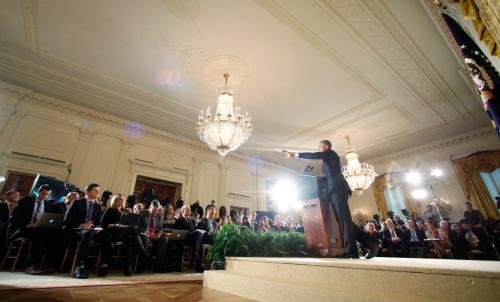
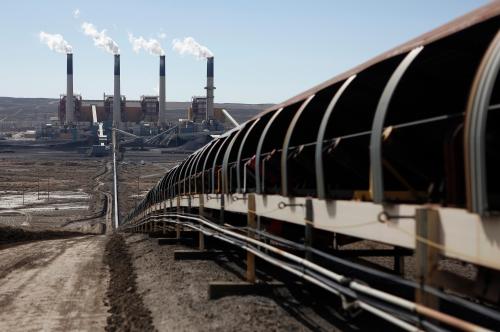
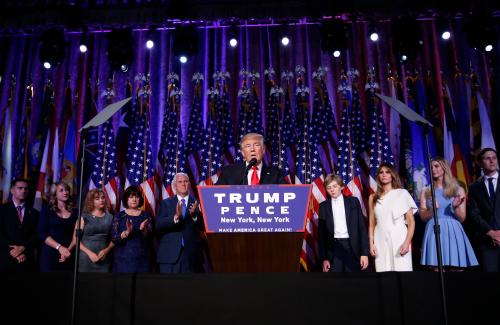

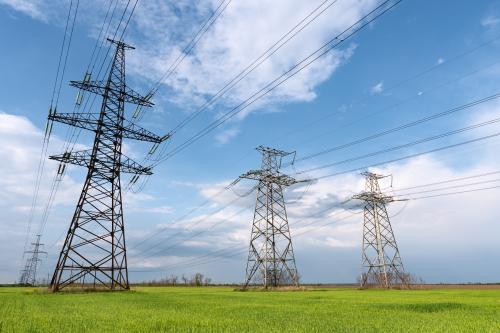
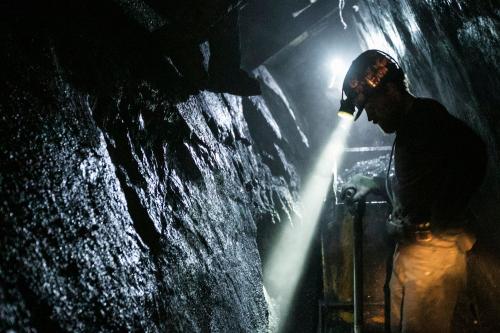
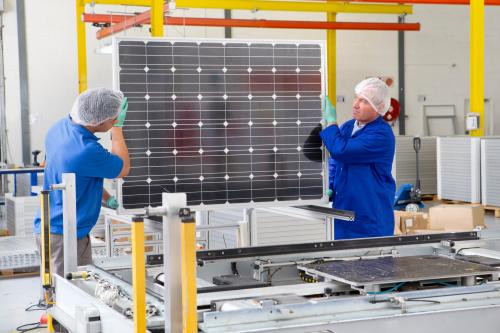
Commentary
What to expect from Trump on energy policy
November 17, 2016